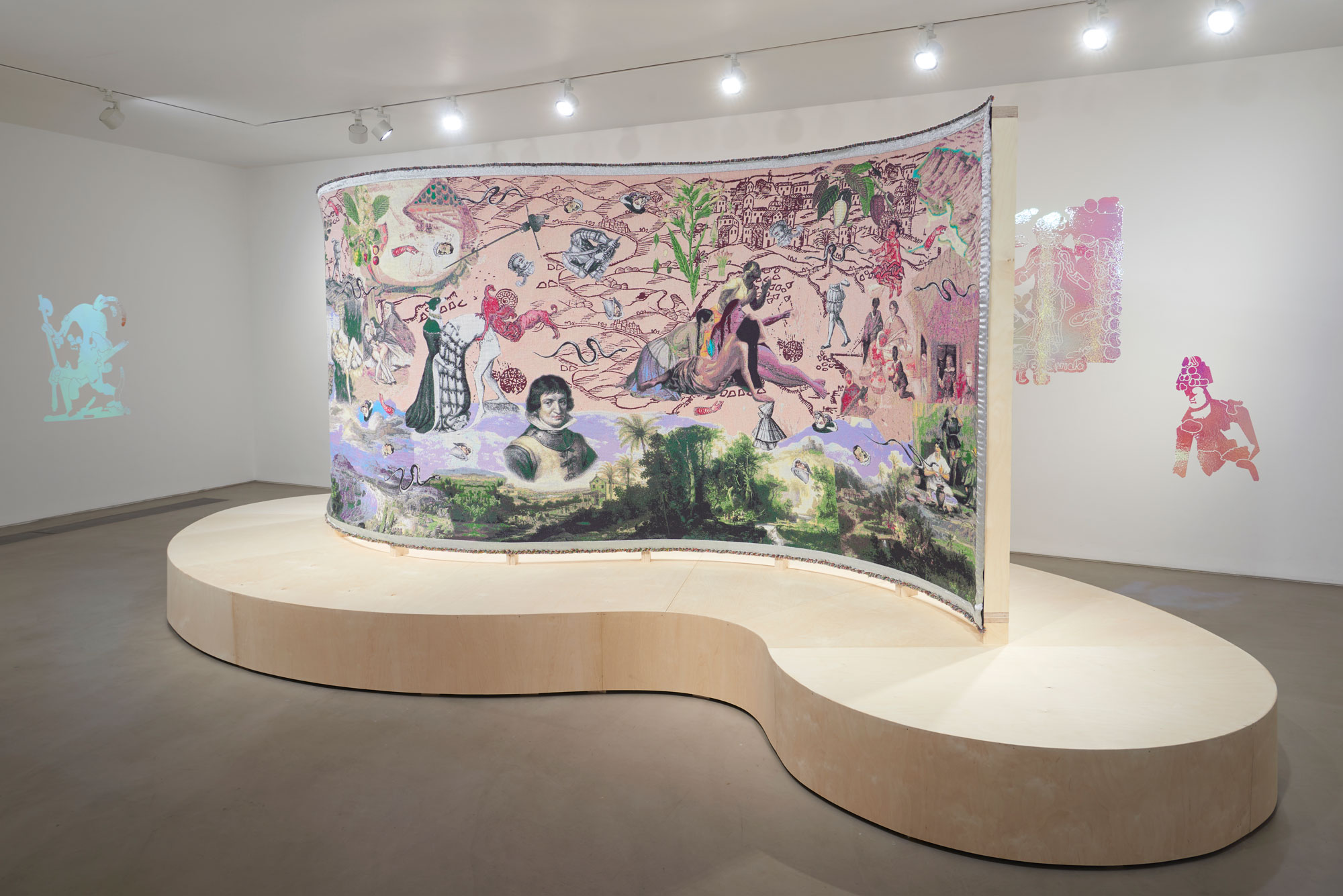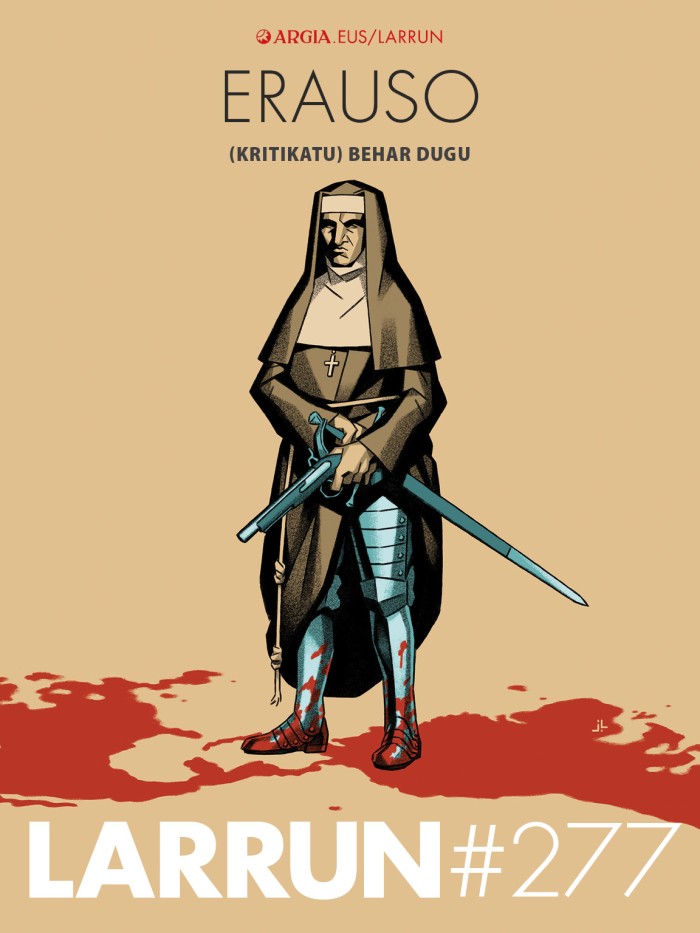Erauso, mirror of ourselves
- The Argentine artist of Basque origin Mercedes Azpilicueta presented last year in London the exhibition Bondage of Passions. Drawing on the history of Catalina/Antonio Erauso, he cultivated there the performativity of colonialism and gender through the textile industry.

The collage of Erauso's travel records united in one giant tapestry and in another the images of the colonized peoples. He also created costumes and artifacts that mix the aesthetics of the 17th and 21st century, related to sexuality, such as highlighting the crotch or hiding the breasts.
He invited three researchers from Euskal Herria to a round table to delve into the context of the exhibition: Amaia Alvarez Uria, professor of literature, archaeologist Sergio Escribian-Ruiz and art historian Haizea Barcenilla. We've repeated the conversation at LARRUN, now in Basque. All three coincide: Erauso is an uncomfortable character for Basque society and for the institutions and, therefore, absolutely necessary.
How did Erauso get to their lives?
A. Alvarez: Erauso has made different visits to me throughout my life. During my thesis about writer Katalina Eleizegi decided I wanted to know her better, as Eleizegi wrote a play about Eraus. So I began to go deeper than the autobiography. I read the doctoral thesis of Eva Mendieta and the essay of Sherry Velasco, among others. Velasco investigates how Erauso has been represented in different artistic manifestations. What is valued and despised depends on the time. This shows us that Erauso is a mirror: depending on who you see, the reading will be different. At first I was struck by the transgression of gender, but the theme of the thesis has been the crossing of gender and national identities.
S. Escribe-Ruiz: I knew little about Erauso until Merecedes Azpilicueta contacted me. He asked me what archeology could contribute by rethinking Erauso. In archaeology, we do not study people or specific dates, but centuries, processes and societies. Therefore, we talk about colonialism in general, and Erauso has been a path for reflection, I end up becoming an erausa. I've become a very attractive character, because in history and in archaeology we tend to essentialism and it shows us how many opposing realities there are.
“I was thrilled to be face-to-face with Erauso.
SERGIO ESCRIGNU-RUIZ
H. Barcenilla: As a Gipuzkoan, since I was a young man, the portrait and history of Erauso have been present in my imagination. As a child, I went to the San Telmo Museum with my parents and school. I returned to Erauso when Mercedes contacted us; the character was not new to me, but a critical approach that joins my professional and personal interests. On the one hand, it is extremely interesting from the point of view of gender performativity. It is striking that the Pope gave him permission to live as a man, although for many of the time he would be a monster. On the other hand, in the contemporary art of Euskal Herria colonialism has been addressed very little, I miss the self-critical discourse. Figures like Elcano tend to make absolutely positive epic legends, which is difficult with Erauso, because it has many edges.
S. Escribe-Ruiz: In Spain we do not want to talk about colonialism, and when we talk about the tone it is absolutely paternalistic: what was done was for the benefit of the indigenous people. In Euskal Herria we have our epic, but I would say that the main attitude of society is indifference, because we do not know where to stand, because there is a huge contradiction from the point of view of national identity. We accuse the Spaniards of colonialism, we deny our historical responsibility. I usually include in my presentations a photo of Esperanza Aguirre with the following questions: Why is it called Aguirre? What has the Basque aristocracy done throughout history? Why is the Recoleta cemetery in Buenos Aires full of Basque military graves? It seems that our task was to bring Euskera and religion to the citizens of Argentina and Newfoundland; on the contrary, my work in these places allows for anti-colonial criticism. It is true that Christopher Columbus asked whether the Indians were humans or animals, while in the Basque chronicles words appear as “friend” or “brother”. Although the relationship was warmer, we did so in our interests, because we went to exploit resources.
How do you value the recognition of Erauso in the Basque Country? Do we have to ask for more monuments or knock down the Miramar Palace?
A. Alvarez: To create the imaginary of Basque nationalism, they have sought saints, characters that fulfill the ideal. Some figures are claimed and others are excluded. Elcano has been the last fichaje dream team in Basque history. However, Erauso’s image is not round, it does not fulfill the characteristics to become a myth. Some will not claim it because it was a massacre colonizer of the Spanish Empire. Others, because she did not play the proper female role and dedicated herself to women. For example, Carmen Errazi, the first president of Euskal Emakume Abertzaleen Batza, lamió as a reference against the Basque woman model for not being female. It is noteworthy that in the history of Mexico or Chile they have stood out more as a historical reference than in our history. The anniversary of Elkano has allowed us to raise the history, discourse and imaginary that we are building in the Basque Country of the 21st century. In this sense, we should like to thank Axier López's book of journalism "Seguro heroiak" and the collaboration with the Elkano Itxaro Borda Foundation.
“We’ve been crushed, but we’ve also been rocking. From this perspective we should rewrite our history”
AMAIA ALVAREZ URIA
S. Escribe-Ruiz: If we celebrate the anniversary of Elcano, even the holiday day, we should also celebrate that of Erauso. Derail or abandon monuments? I would leave them and take them for reflection.
H. Barcenilla: The tendency of tributes is to make a very flat account of the characters, but Catalina/Antonio is a complex person who is immersed in a complex historical process. It has aspects that we believe to be unacceptable today and that today are demanding. I too am in favour of using material heritage to report history. I understand that some monuments can be very offensive and that they must be removed, we will have to study them in each case. I remember the Roman memory damnatio memoriae, one way of condemning a historical character was to destroy its statue, but they also used other options such as distorting the face or removing the statue, but keeping the base with its name for the decision to be clear. We can use these kinds of interventions to add narratives.
Gender and sex dissidents are completely erased from the hegemonic story. Why has Erauso achieved such international visibility?
S. Escribe-Ruiz: He got the approval at the time because he fulfilled the attitude of the patriarchal man with exemplarity.
A. Alvarez: Erauso knew how to build the discourse, to sell himself. He knew what to tell to support the above, and so he did when he gave his autobiography. It was an example of honor in the Spanish Empire: both of the feminine honor (because she remained virgin, in quotation marks!) Both male honor and the very violent combatant and the oppressor of other peoples.
H. Barcenilla: Visibility is necessary to move on to history, but also social recognition. You have to have resources to be able to express yourself. The LGTBQI+ community has had little visibility, because it's been denied, but also because you've avoided it to protect yourself in the patriarchal system. However, Erauso dared to leave his register. This shows that he felt control over his image and that he had enough official acceptance for that visibility to produce no punishment back. So making a picture wasn't like taking a selfie. He could pay the order, but the portrait could be destroyed soon. Did you keep it as a historical character or as a historical curiosity? Why did they make a copy? It would be interesting to know the paths made by these paintings.
How can we recover the history of sexual and gender dissidents who remained far from power?
S. Escribe-Ruiz: When there's a lack of information in a historical era, it's very clear that we project our models, and our models are patriarchal. A clear example of this is the story of prehistory: the current called archaeology of genders has questioned the imaginary of museums, for example, the tendency to represent only men in hunting. Likewise, researchers like Sandra Monton and Enrique Moral work in Quirna or transfeminist archaeology. We are aware of the influence of patriarchy on our activity and we are trying to dismantle it, both in the past and in the present, that is, in the dynamics of academia.

Fernández; below, Sergio Escribian-Ruiz and Amaia Alvarez Uria.
“The Romans was a way to condemn a historical character to destroy his statue, but they also had other options, such as deforming the face or removing the statue, but keeping the base with his name so that the decision would be clear”
HAIZEA BARCENILLA
H. Barcenilla: I've been a professor of art history in the Middle East for many years. I've used Paul Rehak's research to introduce gender and quir. He distinguished that in mesopotamian society there were four genera instead of two genera. It's been very hard for us to identify it because we look at works from binarism. For example, if a figure appears with beard and uncovered chest, we define it as a man, and if it has no slice and the covered chest, as a woman. Thus, we were not able to understand figures that mixed these characteristics.
The authorship and credibility of Eraus's autobiography are questioned. Do you care about the real and the invented?
S. Escribe-Ruiz: In archaeology, we focus on small things. We build the past in many words and start from concrete criteria to solve what is true and what is not. In the case of Erauso, a critical analysis of the writing and the painting is made: In what context does it arise? Why has it come to us? Who created it and why? What was the intention behind it? Each researcher will give relevance or legitimacy to data that meets their ideology or interests, but we must have a solid foundation.
H. Barcenilla: Portrait and autobiography are works of art whose objective is not to clarify the truth but to tell a story for aesthetic and symbolic purposes. This story is always partial, and permeates visions of several people: who has asked for the work of art, who has created it, who has kept it… I don’t mean it is not interesting to analyze Erauso since history, but I really liked the image that Amaia has brought: Catalina/Antonio is a mirror in which we reflect, reflect on how we read history and how we read it. I'm more interested than your truth why today is important to us.
A. Alvarez: For those of us who want to perpetuate, promote, feed and disseminate Basque culture, when we build history it is very difficult to maintain the following trend: to hide or make up what we do not like, that is, to keep it under the carpet. Intersectional feminism has taught us that we have to know how to get out of the role of the victim and, in addition to taking the agency, become aware of our privileges. We have been crushed, but we have also been rocking. From this perspective, we should rewrite our history.
Finally, what did you think of Azkuna's exhibition?
H. Barcenilla: The good thing is that the exhibition has given visibility to people who have lived in secrecy and darkness. However, it seems to me that more juice could be taken from the character. In particular, Cabello/Carceller has not worked the difference of Basque colonialism.
A. Alvarez: I share. They've done a lot of documentary work and they've joined the art artifacts of the 21st century. I liked it, but I had more expectations in producing Erauso. They mention decolonality in a very global way, they have not contextualized it. A tourist visit was made in San Sebastian to see the bust, but they do not seem to approach people here.
S. Escribe-Ruiz: It has generated contradictory opinions like characters. I found it very historic, I expected something more artistic from the scenographic point of view, perhaps through the performance… They have taken little risk. Yes, I was thrilled to be face-to-face with Erauso. I still have a look in my head.
H. Barcenilla: That is what I liked the most: see the two paintings in front. It looks at itself. What are you counting on? However, perhaps because I am very involved in this issue I find it an insufficient exposure, but those around me have had a lot of impact. I should like to know whether it has been a new contribution to the general public.
Despite the black skin and curly hair, they remained invincible men, with the intelligence and resentment of human beings.” So he wrote about the slaves CRL James in the book Jakobino Beltzak, who masterfully narrates the Haitian revolution. So many brutalities, torture and... [+]
Malin, Burkina Fason eta Nigerren Frantzia haizatua da. Mendebaldeko potentziek haien eragina galtzen ari dira Afrikako kolonia zaharretan. Afrika frankofonoko populazioa bereziki gaztea da, eta ez du frantses kolonialismoa zuzenki ezagutu. 35 urtez peko gazteek populazioaren... [+]
Last week I was at the Olaso Tower in Bergara, in a talk about symbol acquisition.
Behind the symbols there is a story, and it is evident that the symbols we have before us – shields, flags, monoliths, street names… – tell the story that suits the empire.
It is not in... [+]
II. Following the World War, the process of decolonization of the countries of Africa and Asia began. In fact, the soldiers of these countries participated in the triumph of Germany and its fascist allies, and “as a thank you” those subordinate countries had to be recognized... [+]
In the bar Gato de Pamplona was singing screaming, the famous song of curse of Malinche: "Eta oker horretan, pasako grandeza eman egingo dugu, eta oker ants three hundred years Geratu gara slaves."
Having a birth in South America, especially in Colombia, is nothing comfortable,... [+]























